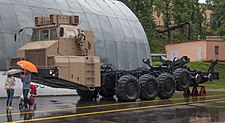Electricity sources[edit]
There are many ways to generate electricity, of varying costs, efficiency and ecological desirability.
Connection to generator plants[edit]
- Direct connection to generation plants as is common among electric trains, trams, trolleybuses, and trolleytrucks (See also: overhead lines, third rail and conduit current collection)
- Online electric vehicle collects power from electric power strips buried under the road surface through electromagnetic induction
Onboard generators and hybrid EVs[edit]
- Generated on-board using a diesel engine: diesel–electric locomotive and diesel–electric multiple unit (DEMU)
- Generated on-board using a fuel cell: fuel cell vehicle
- Generated on-board using nuclear energy: nuclear submarines and aircraft carriers
- Renewable sources such as solar power: solar vehicle
It is also possible to have hybrid EVs that derive electricity from multiple sources, such as:
- On-board rechargeable electricity storage system (RESS) and a direct continuous connection to land-based generation plants for purposes of on-highway recharging with unrestricted highway range[36]
- On-board rechargeable electricity storage system and a fueled propulsion power source (internal combustion engine): plug-in hybrid
For especially large EVs, such as submarines, the chemical energy of the diesel–electric can be replaced by a nuclear reactor. The nuclear reactor usually provides heat, which drives a steam turbine, which drives a generator, which is then fed to the propulsion. See Nuclear marine propulsion.
A few experimental vehicles, such as some cars and a handful of aircraft use solar panels for electricity.
You received this message because you are subscribed to the Google Groups "1top-oldtattoo-1" group.
To unsubscribe from this group and stop receiving emails from it, send an email to 1top-oldtattoo-1+unsubscribe@googlegroups.com.
To view this discussion on the web visit https://groups.google.com/d/msgid/1top-oldtattoo-1/CAMm_%2ByZ5Uc2HBm91NwRW_c2w-Un--sqg9dMB%2Bsw6x-%3DwaFq3GA%40mail.gmail.com.



No comments:
Post a Comment